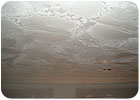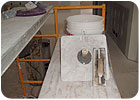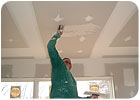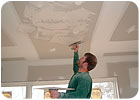
Two years ago, our family-owned drywall company received a phone call from a local, well-known homebuilder who needed a reliable and respected replacement for his recently-departed drywall subcontractor.
Once the legalities of tender and work specifications were settled, our opportunism quickly obliged his need. Until, that is, we discovered the builder required a “buttering” texture applied to ceilings, a texture substantially different from our well-practiced stipple-and-knockdown.

TRYING TO FIGURE IT OUT
Initially, our inability to match the “butter” texture strained the business relationship and our credibility, an unfortunate combination. Yet, we persevered by soliciting direction from friends, foes, and home improvement store experts, while continuing our on-the-job trials with broad knives, broader knives, and far too many buckets of mud. Our failing (or flailing) continued until a man of generosity and construction know-how assisted us by offering another description (sort of like “skip trowel”), origination (plastering) and most helpful, direction and demonstration.Of particular importance when executing the “buttering” texture is the correct selection of tools, a point we ignorantly missed. We had abandoned the hawk and trowel in favor of broad knives years ago. The consideration of our shoulders and the acknowledgement of broad knives’ ease of use prompted this decision. However, when “buttering,” ease of use settles necessarily behind the paramount goal of producing the desired texture; done correctly and inescapably with a hawk and trowel.
Adherence to a few tips can assist in easing the burden of “buttering” and quickening the pace in which it’s done.
An old trowel, one worn down by years of trowel work, is desired to ease the process of buttering. With its bow, the trowel’s corners will resist sharply cutting into the texture, instead gliding over or feathering already “buttered” areas.
Absent an aged trowel, considerably more time and care will be required when using a new trowel. Its rigidity and size will likely require more spacing between “buttered” areas to avoid trowel marks and gouges.
Conversely, a hawk requires scant maturation, as a newly purchased hawk performs as well as an oft-used one. As long as the handle is cushioned to ensure comfort, the hawk is secondary and replaceable; it’s merely a small table, holding the mud.
COMPOUND-WATER IT WELL
The joint compound consistency needs to be thin (or loose, watered down) to ensure mud that easily slides or skips with the trowel.Our joint compound preference is midweight, which provides an easily mixed, creamy, consistent, and smooth-troweling mud. Typically, we’ll add several cups of water to the mud prior to mixing, adjusting the mix until the mud reaches a consistency where no more than four or five trowel scoops (or five-inch knife scoops) will remain on the hawk while working.
Here’s an additional tip on proper consistency: If the spreading of the mud requires robust effort, resembling a hammer by mashing the mud on the drywall; or the mud refuses to adhere to the drywall and hangs down like a stalagmite, then more water needs to be added to the compound.

Beginning to butter: Place the trowel on the ceiling and then make a fluid swipe across the wall, applying mud in varying depths. Pockmarks, holes, drags and unmuddled areas should dominate the drywall.
A QUICK TUTORIAL
With several scoops of joint compound on the hawk, cut the trowel through the mud while simultaneously tilting the hawk back, assisting the transition of mud from hawk to trowel.Now, place the trowel against the ceiling (or wall) and make quick, fluid swipes, making certain to vary the pressure on the trowel, an elemental part of buttering. This inconsistency of applied pressure produces what most of us normally would consider an unsightly mess: Pockmarks, holes, drags and unmuddled areas deliberately dominate the drywall. These wanted, yet seemingly dubious texture impurities (not to include sharp trowel marks or looming globs of mud), are an understandable affront to most drywall finishers who labor hard to produce smooth and unblemished work.

With proper tools, mud, technique, and practice, the ability to “butter” can be added to anyone’s skill set. As well, sometimes an appreciable increase in workload may depend on providing a new or unfamiliar service, even if this additional offering seems only marginal.

Report Abusive Comment